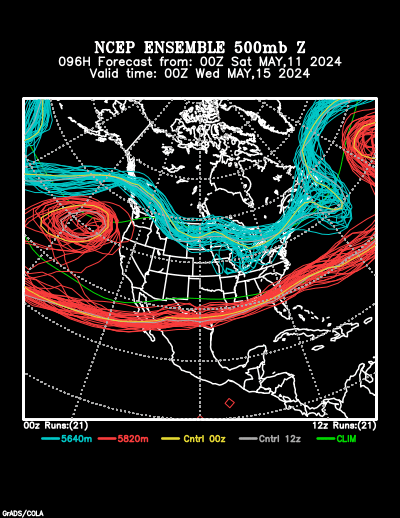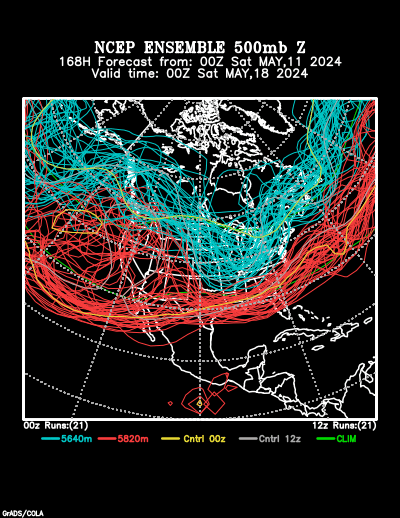I apologize for the somewhat ugly graphics, but here's a "spaghetti plot" of two 500mb height contours from the GFS ensemble. There are 21 ensemble forecasts here of 500mb height and each line represents a different forecast's idea of where that particular contour will be. The cyan color is the 5520m line and the red color is the 5820m line. Let's focus on the cyan lines for now. This is a 96 hour forecast for 00Z Sun (so, Saturday evening in local time) showing a very zonal (east-west) pattern over then north Pacific. This is more or less what we've been seeing for the last week or two. There have been some wiggles along this line as shortwave troughs have come through (bringing us all that rain), but the mean pattern has been rather flat like this.

Fast forward three days to 00Z Wed (Tuesday evening). We can see over the northwest that the pattern is very different. Though there is some (a lot) of uncertainty as to the exact structure here, most of the ensemble members agree that a large ridge will amplify into the Gulf of Alaska with a deep trough digging down into the western US.

This signal has gotten rather robust in the last few runs. What does this mean for our weather? Cold.
The Climate Prediction Center (CPC) has caught on to this pattern change and their longer-term temperature forecasts show it. Below we see the CPC forecasts with high probabilities of below-normal temperatures for the 6-10 day and the 8-14 day timeframes throughout the northwestern quarter of the continental US. There's also a high probability of above-normal temperatures in Alaska associated with that high-amplitude ridge.


And, yet, we are in an El Nino year...a very strong El Nino year at that. One of the things that seasonal forecasters have tried to bank on over the years in the more "robust" patterns in temperature and precipitation that seem to accompany El Nino events. You'll note that the three-month outlook from the CPC shows what is the more canonical El Nino-type pattern, that being warmer temperatures in the Northwest and across the northern tier of the country.

So this is coming as a surprise to a lot of people who had been expecting a warmer-than-average winter. Does this mean everything we understood about what El Nino does is wrong? Not at all...this troughing pattern will probably end up being transient as most weather signals are. We may have a week or so of colder temperatures, but at this point it seems unlikely that this deep trough will be the story of the winter. Remember that when we get toward monthly and seasonal scales we're getting into the realm of climate, where the El Nino patterns are more applicable. Just because on average we expect warmer temperatures doesn't mean we can't get super-cold for a few days.
This could be quite the cold snap, though. If we look at a single model (the University of Washington extended WRF run) we can get an idea of one possibility for how cold the temperatures may be. Here's the extended forecast for 850mb temperatures (which are a few thousand feet above sea level) for next Wednesday at 12Z. The light blue line is the 0 Celsius line (32 Fahrenheit), which you can see dipping all the way into southern California. Remember this is at 850mb, so this is a few thousand feet up. Still impressive.

Actual temperatures at the surface aren't as bad, but still showing below freezing (in the 20s) on Wednesday morning in western Washington.

Temperatures like that would be cold enough for lowland snow in western Washington, which only tends to happen about once a year (at best). That assumes we get moisture, and there is a fair chance of that. This forecast will definitely be something to watch develop this weekend.

No comments:
Post a Comment